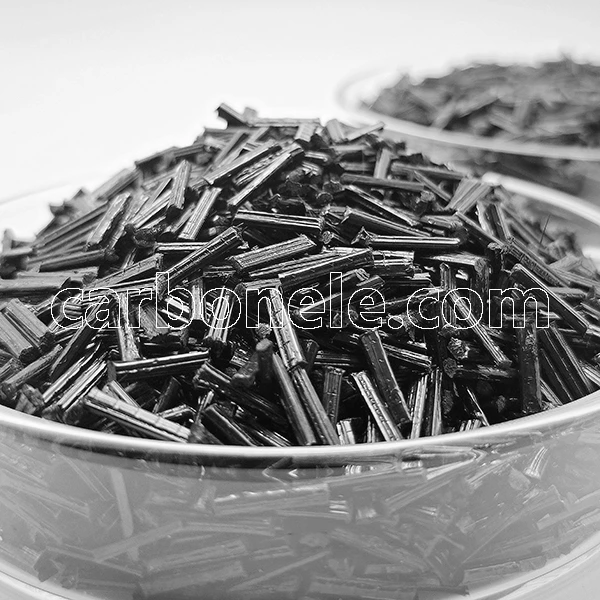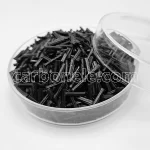
Impregnation Process Methods PPS LCF10 for Turbine Blades
PPS LCF10 is used in a wide range of high-tech industries, including aerospace, automotive, and electronic devices. In the aerospace sector, its high-temperature and corrosion resistance make it an ideal material for manufacturing critical components like turbine blades.
- Model No.: PPS-LCF-BCA1
- Base Resin: Polyphenylene sulfide
- Filler: Long carbon fiber
- Free Sample: 1-10kgs
- MOQ: Negotiable
- OEM/ODM: Accetable
- Molding Process: Injection/extrusion molding
What’s PPS LCF10?
Composition
PPS LCF10 composite material is based on polyphenylene sulfide (PPS) and includes 10% long carbon fibers as a reinforcing filler, with the carbon fiber’s filling mass percentage reaching 20%. This composite material is noted for its excellent performance and wide range of applications.
The main component of PPS LCF10 is polyphenylene sulfide, a high-performance thermoplastic known for its outstanding heat resistance and chemical stability. The addition of long carbon fibers significantly enhances the material’s strength and rigidity.
Performance Characteristics
1. High-Temperature Resistance: PPS LCF10 operates stably in environments up to 260°C, making it suitable for high-temperature conditions.
2. Excellent Mechanical Strength: The reinforced composite material exhibits superior tensile and flexural strength.
3. Lightweight: Compared to traditional metal materials, PPS LCF10 has a lower density, effectively reducing product weight.
4. Corrosion Resistance: The material offers good resistance to various chemicals, extending its service life.
5. Outstanding Wear Resistance: The addition of long carbon fibers provides excellent performance under friction and wear conditions.
6. Low Water Absorption: PPS LCF10 has a very low water absorption rate, making it suitable for use in humid environments.
7. Good Processability: The material is easy to process and mold, making it suitable for mass production.
Applications
PPS LCF10 is used in a wide range of high-tech industries, including aerospace, automotive, and electronic devices. In the aerospace sector, its high-temperature and corrosion resistance make it an ideal material for manufacturing critical components like turbine blades.
A Successful Application Case Share
PPS LCF10, developed and produced by Carbon Xiamen New Material, has been applied in the manufacture of turbine blades for aircraft engines. Traditional turbine blades often suffer from material fatigue in high-temperature environments, affecting overall engine performance. By using PPS LCF10, the component manufacturer successfully addressed this issue.
Experimental validation showed that turbine blades made from PPS LCF10 maintained excellent mechanical performance even at temperatures up to 800°C. The tensile strength increased by 25%, and weight was reduced by 15%. These improvements resulted in a 10% increase in engine efficiency and a 30% extension in maintenance intervals. This project not only enhanced engine reliability but also provided significant economic benefits to the aerospace industry.
How to Manufacture the Composites?
The impregnation method is commonly used by manufacturers to produce this material. Below is a detailed description of the impregnation process:
1. Material Preparation
– Matrix Material: Polyphenylene sulfide (PPS), a high-temperature and chemical-resistant thermoplastic.
– Reinforcement Material: Long carbon fibers, typically 10-30 mm in length, used to enhance the material’s strength and stiffness.
2. Fiber Pretreatment
Before impregnation, the long carbon fibers are usually pretreated to ensure good adhesion to the PPS matrix. This includes:
– Cleaning: Removing impurities and oils from the fiber surface.
– Surface Modification: Chemical treatment or plasma treatment to improve the fiber’s surface properties, enhancing bonding with the PPS matrix.
3. Matrix Material Preparation
PPS is typically in the form of pellets or powders, which need to be melted before processing. This step involves:
– Heating: Heating PPS to its melting temperature (typically 280-320°C) to turn it into a flowable molten state.
– Melting Mixing: In the molten state, PPS can be mixed uniformly using mixing devices (such as extruders).
4. Impregnation Process
– Impregnation: The pretreated long carbon fibers are immersed in the molten PPS. This process can be done through various methods, such as dipping, spraying, or rolling. The carbon fibers must be thoroughly wetted by the PPS to ensure complete coverage and penetration.
– Bubble Removal: During impregnation, bubbles may form, affecting the final material quality. Methods such as vacuum degassing or low-pressure treatment are used to remove bubbles and ensure good impregnation.
5. Cooling and Solidification
– Cooling: The impregnated fibers and PPS mixture needs to cool down to solidify the PPS from its molten state. This can be done through natural cooling or forced cooling (e.g., using cooling plates).
– Solidification: Ensure that the material is completely solidified during cooling to maintain its final physical properties and structural stability.
6. Post-Processing
– Cutting and Shaping: After solidification, the composite material can be cut and shaped as needed to meet the requirements of the final application.
– Inspection and Quality Control: The produced composite material undergoes various performance tests, such as tensile strength, flexural strength, and impact toughness, to ensure it meets design specifications and application requirements.
7. Application
– Application and Molding: The impregnated PPS LCF10 composite material can be used in various high-performance applications, such as automotive parts, electronic device housings, aerospace components, etc.
This impregnation process method’s advantage is its ability to uniformly disperse the reinforcement material (long carbon fibers) throughout the matrix material (PPS), significantly enhancing the composite material’s mechanical properties and thermal stability.
Please advise without delay if you have interest in this product.
For more info on long carbon firber reinforced thermoplastic composites by watching videos, please click here.
PPS LCF10 for Turbine Blades
Why is PPS LCF10 considered an ideal material for manufacturing key components such as turbine blades? PPS LCF10 combines the characteristics of polyphenylene sulfide such as high temperature resistance and corrosion resistance with the high strength and high modulus of liquid crystal polymers. It can maintain stable performance in high temperature environments and withstand the huge stress and thermal shock of turbine blades during operation. At the same time, its good formability is conducive to manufacturing key components with complex shapes, so it becomes an ideal material.

How to Buy the Composites?
Carbon fiber reinforced thermoplastic composites vary in performance due to factors like matrix resin, carbon fiber content and type, and production process. Assess advantages based on application needs and comparison. Different manufacturers' products have different emphases. For more info, refer to product manuals or contact us.

Frequently Asked Questions
Carbon (Xiamen) New Material Co., Ltd. aims to provide buyers with "one-stop" worry-free high-quality services. Here you can find all information about carbon fiber engineering plastics. If you still have questions, please send us an email for consultation!
-
How can I contact the manufacturer of a product that interests me?
When you find a product you are interested in, you can contact the manufacturer directly by sending an email and we will get back to you as soon as possible.
-
How do I find the products that interest me?
All you need to do is enter the keyword, product name in the search window and press the Enter key on your keyboard. Your search results page will then be displayed. You can also search within the product category pages on the home page. Each category is divided into subcategories, allowing you to refine your search and find products that interest you.
-
Where will I find a buying guide?
Please contact our after-sales service directly and we will provide you with a comprehensive operating guide.
-
What are CF Reinforced Thermoplastic Composites?
CF Reinforced Thermoplastic Composites are materials where carbon fibers are incorporated into a thermoplastic matrix. They combine the strength and stiffness of carbon fibers with the processability and recyclability of thermoplastics. For instance, they are used in automotive parts like bumper beams.
-
What are the benefits of CF Reinforced Thermoplastic Composites over traditional composites?
The key benefits include faster production cycles, easier recyclability, and better impact resistance. They also offer design flexibility. An example is in the manufacturing of consumer electronics casings where complex shapes can be achieved more easily.
-
How are CF Reinforced Thermoplastic Composites processed?
Common processing methods include injection molding, extrusion, and compression molding. Injection molding is widely used for mass production. For example, in the production of small components for the medical industry.
-
What industries use CF Reinforced Thermoplastic Composites?
They are utilized in aerospace, automotive, medical, and sports equipment industries. In aerospace, they can be found in interior components. In the medical field, they might be used in prosthetics.
-
How does the carbon fiber content affect the properties of the composites?
Higher carbon fiber content generally leads to increased strength and stiffness but may reduce ductility. A moderate content is often balanced for specific applications. For example, a higher content might be preferred in structural parts of a race car.
-
What are the challenges in using CF Reinforced Thermoplastic Composites?
Challenges include higher material costs, complex processing equipment requirements, and ensuring uniform fiber dispersion. Issues with adhesion between the fibers and the matrix can also arise. An example is in achieving consistent quality in large-scale production.


























